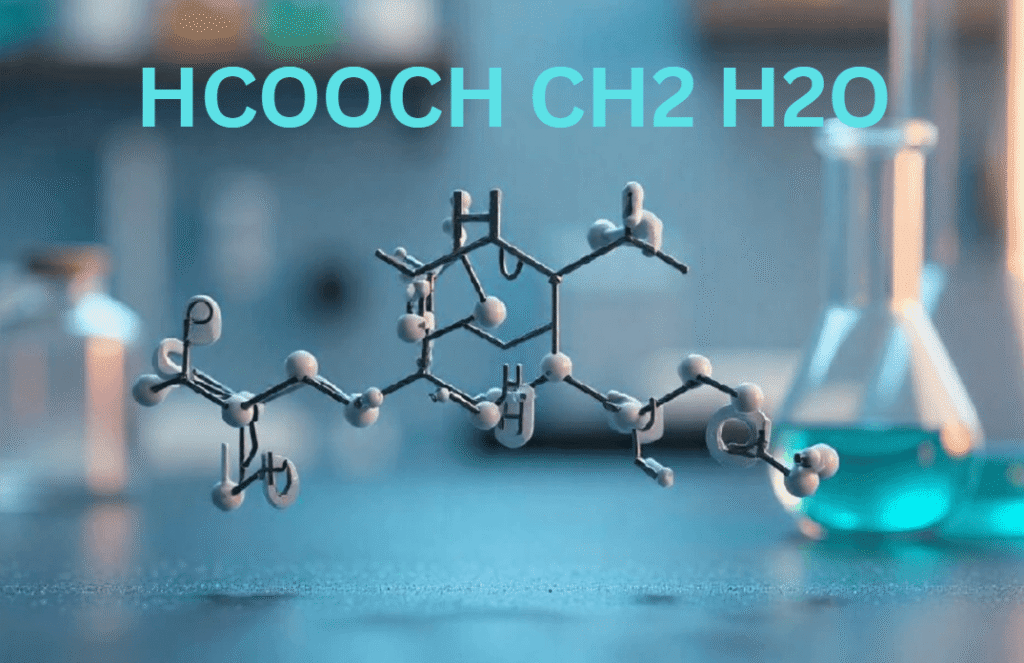Have you ever come across a chemical formula like HCOOCH CH2 H2O and wondered what secrets it holds? At first glance, this combination of letters and numbers might look like a random set of symbols. But in the world of chemistry, every formula has a story. This one, in particular, represents reactions and molecules that can tell us a lot about organic compounds, water interactions, and even industrial processes.
Chemistry is everywhere around us—from the water you drink to the materials used in building your home. Understanding what these formulas mean can turn a confusing subject into something fascinating. Today, we’ll dive deep into HCOOCH CH2 H2O, explore its components, learn how it behaves, and discover where you might encounter its reactions in real life.
Breaking Down the Formula Step by Step
To understand HCOOCH CH2 H2O, let’s take it apart. The first part, HCOOCH, suggests a formate ester, a compound derived from formic acid. Formic acid is the simplest carboxylic acid, commonly found in ant venom and some plants. It’s reactive, small, and plays a role in many natural processes.
Next, CH2 refers to a methylene group. This group often acts as a bridge between other molecules in organic chemistry. It’s like the glue that holds more complex structures together.
Finally, H2O is simply water. But in chemistry, water is not just “plain old water.” It’s a powerful solvent and an active participant in countless reactions. When you see H2O in a formula, you know it could be involved in hydration, hydrolysis, or even condensation reactions.
By combining these pieces, chemists can predict how the compound behaves, what products might form, and what conditions are needed to trigger reactions.
The Role of Formate Esters in Chemistry
Formate esters like HCOOCH are important in organic synthesis. They can act as intermediates when building larger molecules. Imagine you’re trying to construct a complex organic compound. You wouldn’t want to build the whole thing in one step. Instead, you’d start with smaller, easier-to-handle parts like formate esters.
For example, formate esters can undergo hydrolysis in the presence of water. In simple terms, hydrolysis is a reaction where water breaks bonds in a molecule. This process can release alcohols or acids, depending on the starting material. In industrial chemistry, this is a handy way to produce formic acid or methanol derivatives.
Another fascinating point is that formate esters are used as protecting groups in synthetic chemistry. Protecting groups temporarily mask reactive sites on a molecule so chemists can perform other reactions without unwanted side effects.
Understanding the Methylene Group’s Importance
The CH2 group might seem tiny, but it plays a major role in connecting different parts of a molecule. In organic chemistry, methylene bridges are often used to stabilize structures or adjust their reactivity. By inserting CH2 units, chemists can fine-tune how a molecule behaves.
For instance, adding a CH2 group can change how polar or nonpolar a molecule is. This shift can influence whether a compound dissolves in water or prefers to stay in oils or fats. In biological systems, these small changes determine how molecules interact with enzymes or cell membranes.
Water’s Role: More Than Just a Solvent
When we talk about H2O in a reaction like HCOOCH CH2 H2O, we’re not just talking about something to drink. Water acts as a reactant, catalyst, and medium. Its unique properties—like hydrogen bonding—make it essential for life and chemistry.
In hydrolysis reactions, water doesn’t just “sit around.” It actively participates by breaking chemical bonds. In condensation reactions, the opposite happens: water is produced as molecules combine. In both cases, H2O is central to what makes these reactions work.
Possible Reactions Involving HCOOCH CH2 H2O
One classic reaction involving a formate ester and water is acidic hydrolysis. Under acidic conditions, water breaks down the ester, releasing formic acid and an alcohol. In this case, the CH2 group could influence the resulting alcohol’s structure, creating methanol or related alcohols.
Another potential reaction is transesterification, where one ester is converted into another by reacting with alcohols in the presence of water and catalysts. This type of chemistry is widely used in biodiesel production.
Furthermore, in the presence of strong bases or acids, the formate ester can decompose, releasing carbon monoxide and other byproducts. These reactions are not just lab curiosities—they’re used in industrial chemistry to produce valuable chemicals.
Industrial Uses and Applications
Formate esters, methylene groups, and water-based reactions have numerous applications. In pharmaceutical chemistry, they’re used to synthesize intermediates for drugs. Formate esters can also serve as solvents or reagents in the production of fragrances and flavors.
In green chemistry, hydrolysis reactions with water are considered environmentally friendly because they often avoid toxic solvents. Water is abundant, non-toxic, and easy to handle. This makes processes involving HCOOCH CH2 H2O attractive for sustainable manufacturing.

Everyday Examples of Related Chemistry
You might be surprised to learn that similar reactions happen around you all the time. When soap is made from fats and oils, it involves hydrolysis reactions with water—much like the breakdown of formate esters.
Another everyday example is the use of formic acid in preserving animal feed or tanning leather. The same type of chemistry underlies these processes, just on a different scale. Even in baking, water and simple organic molecules react to form flavors and textures we enjoy.
Safety Considerations in Handling Formate Esters
While formate esters are useful, they can also be hazardous if mishandled. They’re flammable and may cause skin or eye irritation. If you were working with HCOOCH in a lab, you’d want to wear protective gloves, goggles, and work under a fume hood. Water, on the other hand, is harmless in most contexts, but mixing it with reactive esters without proper knowledge can produce dangerous gases or heat.
Environmental Impact of Formate Chemistry
Chemists today pay close attention to environmental effects. Using water as a solvent is generally considered eco-friendly. However, some byproducts of formate ester reactions—like carbon monoxide—need careful management to avoid pollution. Fortunately, green chemistry methods are helping industries minimize waste and use safer conditions.
The Science Behind Hydrolysis and Condensation
Hydrolysis and condensation are two sides of the same coin. In hydrolysis, water breaks bonds. In condensation, bonds form, and water is released. Understanding these reactions is key to mastering organic chemistry.
Take proteins in your body, for instance. Enzymes constantly build and break them apart using condensation and hydrolysis. The same principles apply to HCOOCH CH2 H2O reactions. This connection shows how laboratory chemistry and biology share the same fundamental rules.
Learning from Laboratory Experiments
In classrooms and research labs, HCOOCH CH2 H2O-type reactions are often used to teach basic organic chemistry principles. Students might perform hydrolysis of a formate ester to observe how conditions like temperature or acidity affect reaction speed.
By running these experiments, they see firsthand how even small molecules can behave in complex ways. It’s one thing to read about reactions in a textbook—it’s another to watch them happen right in front of you.
Historical Context: How Chemists Discovered Formate Reactions
The study of formate esters dates back to the early days of organic chemistry in the 19th century. Scientists were fascinated by formic acid because it was one of the simplest organic acids known. By experimenting with its derivatives, they began to understand the mechanisms of ester formation and hydrolysis.
Over time, these discoveries led to modern synthetic methods used today in pharmaceuticals, polymers, and materials science. What started as curiosity-driven experiments became the foundation for entire industries.
Why HCOOCH CH2 H2O Matters Beyond the Lab
The importance of understanding HCOOCH CH2 H2O isn’t limited to chemists. Knowledge of these reactions has real-world implications. For instance, industries that make plastics, adhesives, or fuels often rely on similar chemistry. Environmental scientists also study these reactions to predict how pollutants break down in water.
Even everyday cooking relies on the same basic concepts. When you caramelize sugar or ferment dough, water and organic compounds are reacting in ways that echo hydrolysis and condensation.
Challenges in Studying These Reactions
While formate ester reactions may sound simple, controlling them can be tricky. Small changes in temperature, pH, or catalysts can produce unexpected results. That’s why chemists must carefully monitor conditions to get the products they want.
Another challenge is scaling up. A reaction that works well in a beaker might behave differently in a large industrial reactor. Engineers and chemists must work together to optimize processes for safety, cost, and environmental impact.
Modern Research and Innovations
Today, researchers are exploring new catalysts and conditions to make these reactions faster, safer, and more efficient. For example, scientists are studying enzymes that mimic biological hydrolysis, which could replace harsh chemical catalysts. Others are looking at using renewable resources as starting materials for formate esters.
This ongoing research shows that even well-known reactions like those involving HCOOCH CH2 H2O can lead to breakthroughs. Chemistry is never static—it’s always evolving.
Connecting Chemistry to Real Life
If you’ve ever wondered why understanding chemistry matters, HCOOCH CH2 H2O offers a clear example. From the food on your plate to the fuel in your car, chemical reactions shape your world. Recognizing how simple molecules interact with water can help you appreciate everything from environmental science to medicine.
For students, learning these reactions can build problem-solving skills. For professionals, this knowledge can improve manufacturing processes or inspire new inventions. For everyone else, it’s a reminder that science is part of everyday life.
A Friendly Recap
Let’s quickly revisit what we’ve learned. HCOOCH is a formate ester that can undergo hydrolysis with water. CH2 groups act as essential connectors in organic molecules. Water is an active participant, not just a bystander. Together, they represent a small but powerful piece of chemistry that affects industries, biology, and even your kitchen.
Final Thoughts: The Bigger Picture
Chemistry often seems complicated, but when you break it down, it’s full of simple, beautiful patterns. The reaction of HCOOCH CH2 H2O is a perfect example. It’s not just a random formula—it’s a story of molecules interacting, bonds forming and breaking, and human curiosity driving discovery.
By understanding this chemistry, we gain insights into the processes that sustain life and power modern technology. Next time you see a chemical formula, take a moment to appreciate the hidden connections it represents. You might just find that chemistry isn’t as intimidating as it seems—it’s the language of the universe, and you’re already part of the conversation.


